Onion from seeds in one season through seedlings
Hello dear summer residents!
There are many techniques for growing onions. And there are several types of onions. In this article I will tell you about growing onion turnips.
It is planted in the spring (annual heads of turnip onion seeds). And although this is the most hassle-free type of cultivation, I stopped using it because of poor quality planting materialinfected with an onion fly. Even disinfection does not help against it.
It is better to apply for growing onions turnip reception sowing seeds on. Very productive and not too troublesome method. In March I take 5 liter bottles and at a height of 10-15 cm I cut the lid as if. But not to the end. So, we flip the lid and fill the container with earth. We spill, and after 2-3 days we sow the seeds.
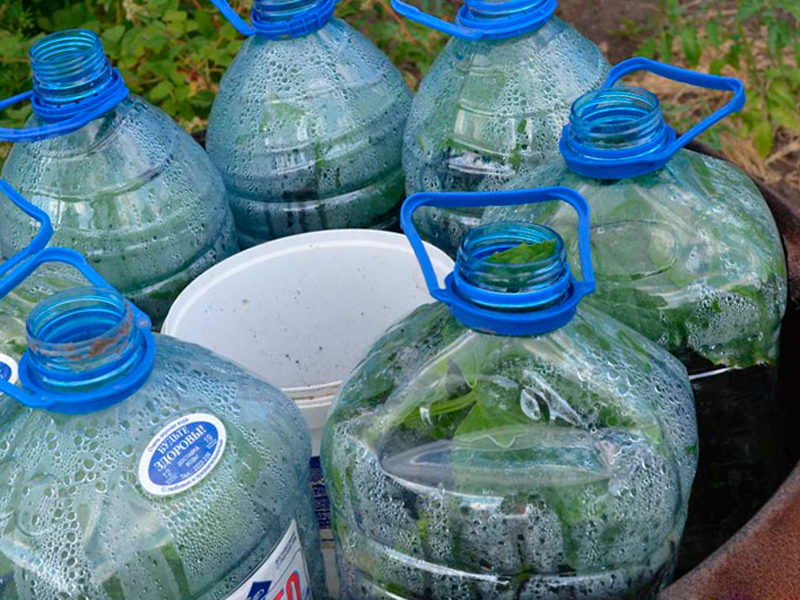 Before that, I keep the seeds in the germinator for 24 hours. After planting, sprinkle the seeds with earth and return the top-cover to its place. I fix the cut with tape. So the bottle will go to the country. Watering is not particularly necessary, since there is almost no vapor. But if the need arises, I pour a large enema through the neck of the bottle. And on the walls!
Before that, I keep the seeds in the germinator for 24 hours. After planting, sprinkle the seeds with earth and return the top-cover to its place. I fix the cut with tape. So the bottle will go to the country. Watering is not particularly necessary, since there is almost no vapor. But if the need arises, I pour a large enema through the neck of the bottle. And on the walls!
In early April, I bring the bottles to the country and put them in the sun under the acrylic, but not on the ground, but on a board above the ground.
 I plant seedlings in early May in the ridges. 2-3 hours before planting, I take out the sod with onions from the bottle and lower it into a basin with water. There, the roots of seedlings are very easily washed out and disassembled.
I plant seedlings in early May in the ridges. 2-3 hours before planting, I take out the sod with onions from the bottle and lower it into a basin with water. There, the roots of seedlings are very easily washed out and disassembled.
My way of landing - under the heel (that is, the leg from the sofa). I make a groove on a ridge with a flat cutter and in them, after 15 cm, I squeeze the holes with a heel. I put a spine in the hole, slightly deepening, pouring a glass of water and slightly pulling out the sprouts to straighten the roots. I put the humus in the hole with my other hand. I dig to the core.
Before planting in each hole I put the universal "AVA". And in the water for irrigation I stir a handful of ash and.
As soon as the onion lifts its head (within 10 days), immediately a bed and constantly spill with fertilizer "Radiance". I add mulch twice a season. I don’t rake onions, because the earth under the mulch is loose, and the onion itself will find a convenient place.
When the feather on the bow begins to fade and lie down, I put it on the bed of the arc and pull the film from the rain. And, of course, I stop watering.
In the second half of July, onions can be harvested.
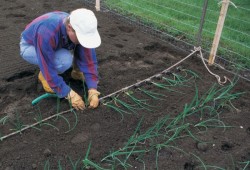
I tried for quick consumption of onion varieties "Music" , "Exhibit" , "Ecstasy" , Bonus . And for storage, bulbs are more dense and smaller in diameter, for example a grade "Farmer" .
Planting onions in the winter - how and when to plant onions in autumn 2016Dates of onion planting in the fall.
It has long been known that onions can be planted in spring and autumn, but for some reason, planting onions in the winter was not widespread until recently. Planting onions for the winter in the coldest regions — in Siberia, the Urals, and the Moscow Region — was especially wary, and today there are many varieties of winter onions that winter well in the soil, but next year they give an early harvest. How to plant onions in autumn, when to plant winter onions, how to protect it from winter frosts - we will answer all these questions in this article.
If you believe the lunar calendar, then the most auspicious days for planting onions in the fall of 2016 - September 19, 23, 24, 25 and 30, and also on October 9, 27, 30. Those who did not have time on these dates remain on November 17, 19, 24, 25, 26, 27 and 28.
The best time for planting onions in areas with not very cold winters from late October to early November is 30-35 days before the onset of persistent cold. Keep an eye on the outdoor thermometer: if the temperature drops to 5 ºC and lasts for several days, then it's time to plant the onions.
When onion is better not to plant.
In general, you should be guided by the weather: onions must have time to grow roots before the onset of cold weather, but sprouts should not be allowed to occur. If you plant the onion ahead of time, it will go in the arrow and die from frost, with a late landing there is a risk that the roots will not have time to develop, and the seedling will freeze in the ground. Some gardeners believe that planting onions in the ground at the end of November is the best solution, but in this case the result depends only on luck.
Planting winter onions
After what culture to plant onions.
Often not knowing after which it is possible to plant onions, gardeners make mistakes that lead to low yields. All cereals except oats, corn, beets, mustard, canola, phacelia, peas, beans, tomatoes, lettuce, cucumbers and any cabbage are considered to be good predecessors for onions. To prevent nematodes from infecting the onion, do not plant it after beans, potatoes, parsley, celery, alfalfa, and red clover. You can grow winter onions as a second crop after harvesting rapeseed, winter barley, beans, peas, radishes, carrots and table beets, if you managed to harvest the first crop before the third decade of July. They often ask the question, is it possible to plant onions after onions. Onions in one place can be grown no more than two years, next time onions in this area, as well as in the area where garlic grew, can be planted no earlier than four years later.
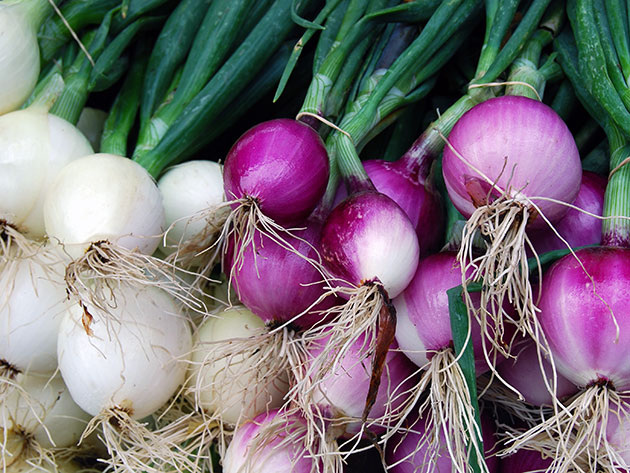
Onion before planting - preparation.
Onion planting material is divided into oatmeal (onions less than 1 cm in diameter), sevoc (onions from 1 to 3 cm in diameter) or onion picks - onions larger than 3 cm. If you are planting onions for greens, it is better to use sampling, since a large onion is more often goes to the arrow, and shallow sowing is planted to obtain turnip bulbs. Therefore, sort the seed before planting in the soil, separating the shallow seed from the larger sample, do not cut the onion neck. Professionals recommend a sowing and a breeze for winter planting, since they winter storage they can dry in the room, and if they are planted in the ground, then next year they will give large bulbs.
Primer for onions.
One of the components successful cultivation winter onion is right choice plot. Where to plant onions to create optimal conditions for its growth and development? The soil for onions should be light - well-drained humus-sandy soils or humus loam on the south or south-west slope, protected from the wind, are most suitable tall plants. The onion is weak root systemtherefore he needs fertile soil. The most remarkable onions grow on silt sediments in the valleys of warm rivers. The soil before planting needs to be dug in advance with humus (5-6 kg per m²) and mineral fertilizers at the rate of 10-15 g of potassium salt and 20-25 g of superphosphate per m². Instead of mineral fertilizers, you can make ecofosk from the same calculation. Before planting, it is advisable to sprinkle ash over the plot at the rate of 10 g per m².

Planting onions sevkom in the winter.
How to plant onions? Level and compact the surface of the site, make grooves in the soil with a depth of about 5 cm at a distance of about 15-20 cm from each other. Spread dry shallow sowing along the grooves after 5-7 cm, cover it with dry earth and lightly compact it. Watering winter onions after planting is not necessary - to moisten the site, if there is no rain, you can do it in ten days. When frosts occur, mulch the area with winter onions with dry leaves, spruce branches, pine needles, and from above squeeze the shelter with branches so that it is not crushed by the wind. If a cold and snowless winter is expected, you can cover the area on top of the mulch with film. You will not need a film in the snowy winter.
Planting onion-batun, which is grown exclusively for its greens, is no different from planting onions, but at the shallots, the necks are cut off before planting and then the onions are kept in water at a temperature of about 30 ºC for a day.
Onion care after planting in the fall.
Planting and caring for onions in open ground simple and easy. As soon as the soil starts to warm up in the spring, remove the film from the winter onions, and after a week remove the mulch, sprinkle the area with ash at the rate of 10 g per m², and loosen the soil. If you remove the shelter too late, the onion can get wet under the film, and the mulch will delay the passage of the sprouts through the thickness of the earth. It is advisable to loosen the soil after each rain or watering, while simultaneously freeing the area from weeds. The formation of four leaves at the seedlings indicates that the bulb began to form, which means that it is time to introduce a second top dressing, but before that, thin the onion if it grows too densely. Pulled plants can be eaten. As a second top dressing per 1 m² of planting, 15–20 g of superphosphate and 10–15 g are applied potash fertilizer, and it is better to pre-dissolve the superphosphate granules and ash in a solution of fermented herbs. Instead of mineral fertilizers, you can add liquid chicken manure. If the spring is wet, the onions are watered infrequently, but if there is heat and dry land, you will have to arrange watering twice a week. So that your crop is not destroyed by the onion fly, plant marigolds or calendula along the perimeter of the plot with onions - this is guaranteed to save you from trouble. Winter onions ripen about a month earlier than planted in spring.
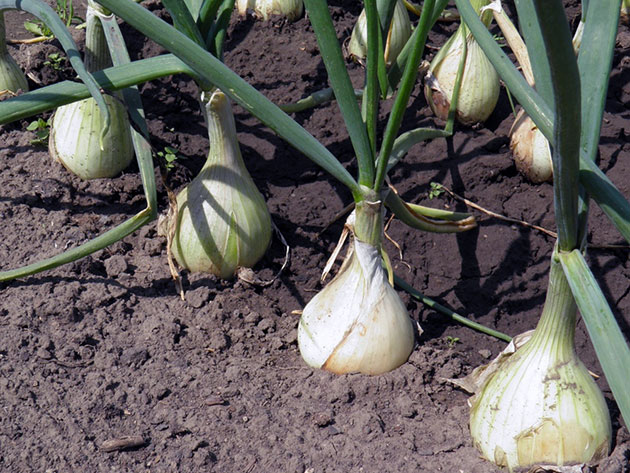
Features of planting winter onions
Planting onions in the suburbs is almost no different from cultivating in Ukraine or other warm regions. The problem can only become too cold winter, but if the temperature does not drop below -15 ºC, and you cover the onions for the winter, then it will not freeze. If the frosts are stronger, but there will be a lot of snow, then one can only hope that in this case everything will go well.
Planting onions in the winter in the Urals.
Planting and caring for winter onions in the Urals are somewhat different from growing this crop in areas with temperate climate. For example, planting dates are shifting closer to early fall - from late September to mid-October. Shelter for the winter in the Urals is necessary, in addition, not every variety can be planted under winter in the Ural climate, but only those that have high winter hardiness.
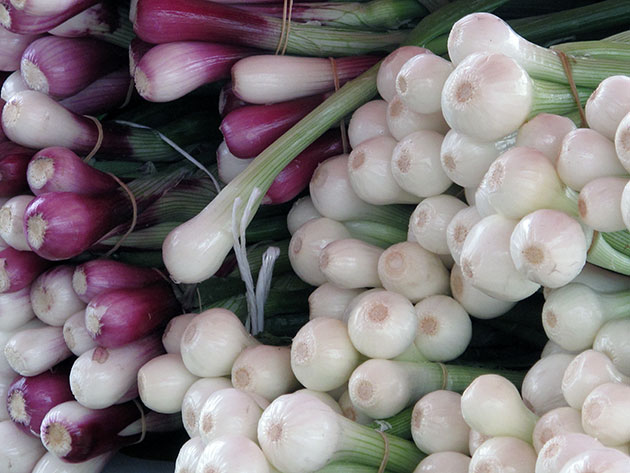
Planting onions in the winter in Siberia.
Unfortunately, vigorous Siberian frosts do not allow us to speak with confidence about the possibility of cultivating winter onions in this region. If you guess with the planting dates, with the variety and with the winter weather, it is quite possible that your efforts will succeed. But if you're out of luck, you can always sow onions in the spring.
Varieties of winter onions
We offer you an acquaintance with some varieties of winter onions, among which you can choose those that are suitable for growing in your area.
- - Ruby - a variety of Donetsk selection. Early ripening onions with a growing season of 72-85 days with good keeping quality and productivity of 3 kg / m². A round bulb weighing 50-80 g light purple with a silver tint.
- - Siberian annual - early ripening variety with a growing season of 60-70 days, leafyness strong, taste semi-sharp, bulb roundly flat yellow in color. Variety with good keeping quality and resistance to shoots. Productivity 4 kg / m².
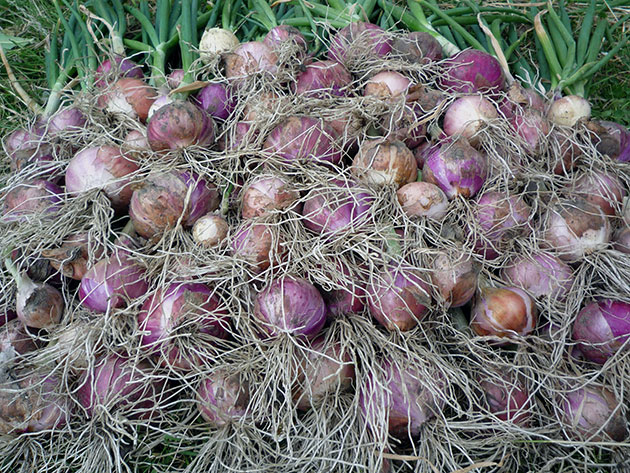
- - Robin - has the most juicy red color of all red bows. This hybrid has a powerful root system, it tolerates drought, is productive. The bulb is in the form of an amphora. A cultivar for cultivation in the southern regions was developed.
- - Mouzon is a mid-early variety ripening from the set in 90-110 days. Bulbs are dense, round, white, weighing 100-120 g. Onions of this variety are stored for two months. It is cold-resistant.
- - Lugansk is a late-ripening variety with a sharp taste and good keeping quality. Round bulb - flat or oval, integumentary scales yellow or tan, the mass of the bulb is 70-145 g.
- - Buran - a variety of Ukrainian breeding for universal use with a round dense bulb of intensively yellow color weighing up to 100 g. Shelfiness is good, yield is stable, but is affected by peronosporosis.
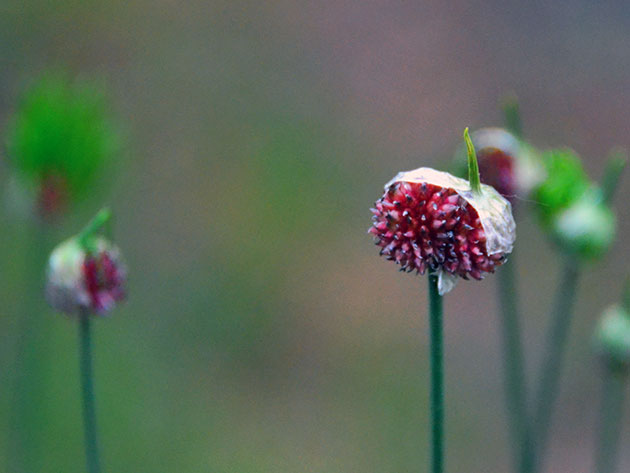
- - Tamara F1 - a mid-early hybrid with dense bulbs with tan scales and a semi-sharp taste. It is stored for a long time, it is resistant to fusarium and pink rot, high yielding.
- - The Black Prince is a mid-season variety of Russian breeding of high keeping quality with a semi-sharp taste and dense rounded bulbs of dark purple color.
- - Stuttgart Riesen - a German variety with flat and flat-round bulbs of golden brown color, spicy taste. Shelf life is good, but is affected by cervical rot and powdery mildew.
- - Panther F1 - a variety of Japanese selection with a bronze-brown bulb of rounded shape and a thin neck. The variety is resistant to shooting and cold-resistant - withstands -28 ºC.
To the onion family belong such common plants in our gardens as onion-batun, onions, shallots. They are grown for the first spring greens, rich in vitamins and phytoncides, as well as bulbs, which are used in the preparation of various dishes and canning. Most onions are unpretentious crops, and grow good harvest subject to certain simple rules even a beginner gardener can.
In one place, growing onions for more than 2 years is not recommended. The best predecessors for onions are cucumbers, cabbage, potatoes and legumes. In addition, you can plant onions and garlic after beets, zucchini, squash. Bad precursors are carrots and tomatoes.
Pests. The main pests of onions are onion flies. To combat them, dig the ridges on which onions or garlic grew in the fall, treat the seed with insecticides before planting, and heat the onion sets for 24 hours at a temperature of + 40-45 degrees. A good result is the use of ash or tobacco dust if you sprinkle onion beds with them, as well as watering the plants with a solution of water and sodium chloride (200 g per bucket of water).
The main diseases. Of the diseases affecting onions, the greatest damage to the crop can be caused by cervical rot, as well as false powdery mildew. For control and prevention immediately after harvesting, it is recommended to dig the soil and add slaked lime or ash to it. Damaged plants are recommended to burn.
How to grow onions
Onions - a universally familiar culture grown to produce bulbs and feather (i.e., greens). There are several varieties of onions, which differ in ripening time, color of bulbs and taste. A good crop of this crop can be obtained several times a year: in spring and summer in the garden, in autumn and winter in greenhouses. A small amount of greenery can be grown even in an apartment on the windowsill.
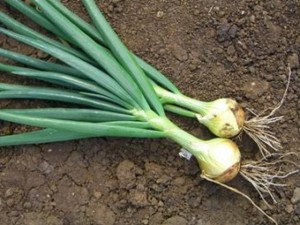
Temperature mode. Onions are a quite cold-resistant crop; its seeds germinate well at + 3-5 degrees. And the optimum temperature for growing the plant is 23-25 \u200b\u200b° C, hotter weather can adversely affect crop productivity.
Landing Methods
To get the bulbs, plants are planted in the ground using seedling and seedlings, and onions can also be grown from seed.
Reckless cultivation. The easiest way to plant onions is seedling. Sow the seeds directly into the ground, dipping them 1-1.5 cm into the soil (so that the seedlings appear faster soak the seeds first).
Harvest of onions can be harvested 23-24 weeks after planting, which makes this method of cultivation suitable only for areas with a mild climate, in which planting can be carried out in early spring. IN middle lane when planting in open ground, onions may not have time to ripen, so in order to get a good crop, use the winter sowing or seedling method.
Carry out winter sowing after the onset of steady colds so that the onion does not have time to germinate. Prepare the beds in advance, until the soil is frozen. Sow the seeds into the furrows to a depth of 5 -6 cm, sprinkle with a layer of humus 2-3 cm on top.
Growing onions through seedlings.To receive strong seedlings sow seeds in March in shallow boxes or special cassettes. Use for ready-made soil mixtures or fertile garden soil. After sowing, cover the boxes with foil and maintain the temperature within 18-25 ° C, when seedlings appear, transfer the boxes to a cool place (10-12 ° C) so that the sprouts do not stretch.
After a week, you can increase the temperature by 6-8 ° C. Remove the shelter for several hours a day for ventilation. Water the onion seedlings in 2-3 days. You can feed her 1-2 times min. fertilizers (20 g of ammonium nitrate, 15 g of potassium chloride and 40 g of superphosphate in a bucket of water).
Planting seedlings in open ground. Before planting seedlings in open ground, it is a good idea to harden it.
Seedlings are best planted at a distance between rows of 10-12 cm, between plants in a row - 6 cm. To prevent plant roots from being damaged when planting, it is best to transplant onions with a lump of earth. Before planting, water the soil abundantly on previously prepared ridges.
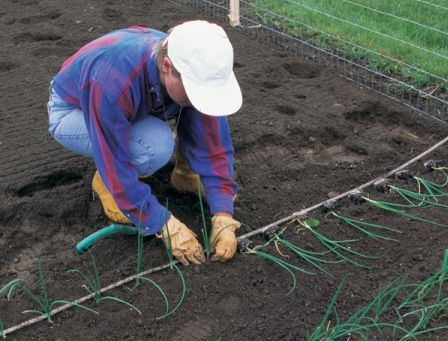
Planting onion seedlings.
The easiest way to plant onions. A less troublesome way to grow onions in areas with a temperate and cool climate is to plant sevka (small onions grown from seeds). Land in the first decade of May, making holes with a scoop or peg and deepening the bulbs by about 1 cm (try not to sprinkle the neck with earth). Plant sowing at a distance of 20-25 cm between rows and 5-10 cm between bulbs. It is convenient to use a two-row tape landing at a distance of 20-35 cm between rows and 5-10 cm between bulbs.
In closed ground, when growing onions on a feather (on greens), use planting as a planting material.
Preparing the soil for planting onions
A good crop can only be obtained by planting in well-lit, sunny areas with rich soil. Onions do not tolerate moisture stagnation, so this crop is best managed in drained areas. The soil on them should not be clay.
A plot for growing onions is best prepared in the fall. Dig the ground to the depth of the bayonet of the shovel, remove the roots of the weeds, introduce the rotted manure, mineral fertilizers. In spring, loosen the topsoil, then flatten everything with a rake.
How to water
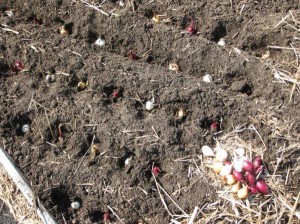
Winter landing of onions.
Onions during the formation and growth of leaves should be watered regularly (in May - once a week, and in June - once every 10 days), loosen the soil between rows between rows and carefully weed. However, remember that for the ripening of bulbs you need a completely different humidity regime, so completely stop watering 3-4 weeks before harvesting.
When growing onions on greens in sheltered soil, water the soil as it dries and loosen it in between waterings.
How to feed and fertilize onions
When growing onions in open ground, top dressing per 1 m2 according to the following scheme: in autumn, when preparing the soil, add 4 kg of compost and 100 g of potassium sulfate; in the spring before planting - 25 g of nitrogen fertilizers; after the formation of the first leaves - 20 g of nitrogen-phosphorus fertilizers, and 5-7 days after that, fertilize the plants with manure diluted in water (in a ratio of 1: 10) or bird droppings (in a ratio of 1: 20).
To get a good crop, carry out another dressing during the onion formation period: add another phosphorus and potash fertilizers from the calculation of 15-25 g per 1 m2.
If you notice that the onion grows slowly and its leaves turn white, add a mixture of 200 g of mullein and 20 g of urea dissolved in a bucket of water. After 15 days, feed the plants with another nitrophosphate solution.
Onions grown by sowing seeds (nigella) are fed for the first time in the phase of the appearance of the fourth leaf with infusion of mullein (1:10) or chicken droppings (1:20), consumption - a bucket of 3-4 square meters. m. In the row-spacings, grooves are made with a depth of 6-8 cm, watered with fertilizer infusion and covered with soil. Two weeks later, a second top dressing is carried out: a teaspoon of urea and potassium sulfate, 2 teaspoons of superphosphate per square meter. m
When growing onions on a feather in open or closed ground, apply complex fertilizers (1 time in 10 days).
Planting and growing onions - leeks
Leek is a relatively new culture in our country, which is less common in other gardens than other onions. This type of onion is more common in the southern regions (this is due to a rather long period from emergence to harvest).
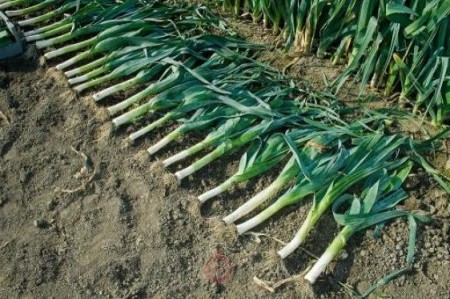
Leek is grown to obtain a thickened lower white part of the stem (this plant does not form bulbs), if desired, you can also use young green leaves for food. The main conditions for obtaining a good crop of this crop are the correct selection of a site for planting and timely fertilizer application.
Temperature mode
In order to get a good crop, the average temperature during the growing season should be 17-23 ° C, although in general the culture is cold-resistant and can withstand short-term freezing up to -7 ° C.
When growing leeks in seedlings, plant seedlings in the soil when the soil warms up to +10 ° С.
Onion planting - leek
In the southern regions of our country, leeks can be grown by sowing in open ground, in regions with a cool climate a seedling method of cultivation is recommended - in this case you can get a crop in the year of sowing (about 45-60 days after the seedlings are planted in beds) . Ripening dates depend on the precocity of the variety, on weather conditions and the fulfillment of agrotechnical requirements.
To accelerate the emergence of seedlings, pre-wet and germinate the seeds. Seedling care is about the same as growing onions: regularly water the seedlings. You can make liquid complex fertilizers once. Optimum temperature for the growth of seedlings of leeks - 18-25 ° C before seed germination and 14-16 "C after emergence. If the temperature is higher and the lighting is insufficient, the seedlings will be drawn out.
Planting seedlings in the ground spend in late April or early May. Plant in furrows with a depth of 10-15 cm (the distance between individual plants is not less than 10 cm). After 2 weeks, cover the furrows with fertile soil.
The soil should be fertile and necessarily loose, best neutral. On acidic soils, a good yield of leeks will not succeed.
How to water onions
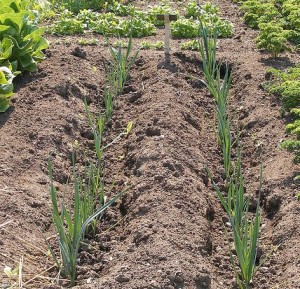
Planting leeks.
Leek is a water-loving plant, so do not forget to regularly water it from the time of seedling planting until the end of the growing season, increasing the frequency of watering in the drier months. After each watering, loosen the row spacing.
Onion hilling
In order to grow juicy bleached stems and high yield, 3-4 times a season, carry out the hilling of leeks. And of course, besides this, do not forget to weed out and loosen the soil.
Top dressing
Regularly feed leeks - without this, you will not be able to get a good crop. Particularly important for leeks are nitrogen fertilizers - They are especially necessary in the second half of summer, when greenery is actively formed.
Optimal will be the alternation of liquid organic fertilizer, for example, an aqueous solution of mullein 1: 8 or bird droppings 1:20 at the rate of 3 liters per 1 square. m. and mineral fertilizers (for example, a solution of ammonium nitrate and potassium sulfate at the rate of 15-20 g per 1 m2).
Planting and growing onions - shallots
Shallots or family, multi-nested onions are appreciated for their early maturity and taste. This species is less common than onions. In one nest, several medium-sized bulbs are formed, which have a less acute taste than ordinary onions. Shallots can be grown in open ground on bulbs and feathers, in closed ground on feathers. Shallot leaves do not coarse for a long time and remain juicy.
Temperature mode
Shallots tolerate low temperatures. If you leave it to winter, it can easily withstand freezing up to -20 degrees, and in spring the greens will appear earlier than other types of onions. The optimum temperature for shallots during the growing season is 20-24 ° C.
Planting shallots

Growing shallots.
Shallots are easiest to propagate by the vegetative method - planting bulbs, and for the cultivation of new varieties, the seed method of propagation is preferable.
Bulbs soak before planting for 20-30 minutes in a pale pink solution of potassium permanganate, and then rinse with cold water.
Landing in the spring (from late April to early May) or in autumn (from late September to early October). For spring planting use medium bulbs (3-4 cm in diameter), for smaller ones - smaller (about 2 cm in diameter).
Plant bulbs to a depth of 2-4 cm, with autumn landing mulch them with peat or earth with a layer of 3-4 cm.
For large shallots experienced gardeners They suggest planting in spring, planting bulbs 15 cm from each other, and between rows 30 cm. During the cultivation periodically tear out one bulb from each nest (they can be used as food), so that by autumn 1 2 onions.
When growing shallots on feathers in sheltered ground, plant from the second half of February, then in the spring you will collect the first crop of greenery.
When forcing shallots on a feather, the bulbs can be reused. To do this, after cutting the greens, remove them from the soil, cut across and again put them in boxes or pots with a fertile soil mixture.
Tillage
When growing shallots in open ground in spring, remove cover material from the beds as early as possible so that the soil warms up faster. In this case, you will accelerate the harvest of greens.
After the emergence of seedlings, plow the soil in the aisles and rows and carefully weed the weeds.
Aisles are recommended to be loosened 2-3 times during the summer to a depth of 5-6 cm, after each irrigation it is enough to loosen the soil to a depth of 3-5 cm. During loosening, it is not recommended to add soil to the plants themselves, since this slows down the maturation of the bulbs.
If you grow shallots in a greenhouse, loosen the soil not deeply, but after each watering.
Watering
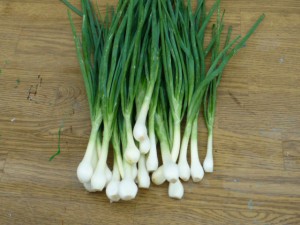
In the first half of the growing season, water shallots regularly: from May to mid-July - 3-4 times a week, in hot and dry weather you can increase the number of irrigations. In the second half of summer, watering should be less already, and you can stop watering 2-3 weeks before picking the bulbs.
In shallow water, water shallots regularly, but in moderation. Loosen after each watering.
How to feed shallots
During the entire growing season, it is recommended to feed shallots 1-2 times (this is enough to get a rich harvest both in open and in closed ground). Use water solution mullein (in a ratio of 1: 10), bird droppings (in a ratio of 1: 15) or complex mines. fertilizers (based on 20 g per 10 l of water).
Planting and growing onions
Onion - a batun is perennial, it can be grown in open ground and in greenhouses. In one place, the plant can be successfully grown for several years, but in the third year its yield decreases, the leaves become coarser.
In culture, there are several varieties of onion, which can be divided into two main groups. Early ripening peninsulas yield crops already in early spring, late ripe acute ripen 30-40 days later. Growing onion-batun is simple, especially if you plant varieties that are resistant to disease.
Temperature mode
Onion-batun is a winter-hardy culture; it tolerates frosts up to -45 ° С. The optimum temperature for vegetation is 19-23 ° C.
Sowing onions -

Onion-batun can be propagated by seedlings and seedlings. Planting seeds in open ground begins at the end of April, to a depth of 2 cm. The simplest method is row sowing at a distance of 40-50 cm between rows, but you can also use a tape sowing scheme: sow seeds in 2-5 rows at a distance of 10 cm between in rows and as much between plants.
Onion - a batun easily propagated vegetatively. To do this, simply divide the bushes and plant each onion separately. It’s best to do this in spring or late summer. Plant the bulbs in rows.
To get a good crop, plant a spring onion, in extreme cases, in summer or early autumn.
For distillation in winter time in the autumn, dig a few plants and transplant them into boxes, put them in a warm, bright place and water 2-3 times a week.
Getting an early onion crop
To get early greens in late February - early March, plant a spring-onion in film-type tunnel greenhouses. This method will allow you to get the crop two, or even three weeks earlier (while it will be 1.5-2 times higher than when growing onions in open ground).
You can use a frameless shelter: sow the seeds of onion-batun in the open ground and cover it with a perforated film, sprinkling it along the edges of the ground.
For distillation on feather, onion-batun can be grown in a greenhouse. In autumn, plant delenki in rows, and already in March, when the onion leaves grow by 15-20 cm, collect the first crop.
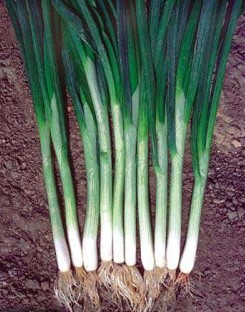
When growing onion-batun in a greenhouse, make small furrows on the ridges, plant onions in them and fill them with soil. To get a good crop, maintain a temperature of + 10-15 C in the greenhouse, gradually increasing it to 20 C. Optimum humidity air - 70-80%. 7-10 days after planting, apply mineral fertilizers to the soil.
Loosening
Cultivating row-spacings is the key to obtaining a good onion crop. A few days after the first weeding, plow the soil between the rows of plants.
Watering
For fresh juicy greens, do not forget to water the onion (in case of lack of moisture, its leaves coarsen and become bitter). The recommended norm is 3-4 times a week for 10-20 l / m2. 3-4 hours after watering, open the aisles.
How to feed onions - a batun
To get a good onion crop, do not forget to feed it with mullein diluted in a ratio of 1: 8 or bird droppings (1: 20), one feeding per season is enough. After harvesting, it is advisable to apply liquid mineral fertilizers (50 g of ammonium nitrate, 3 g of superphosphate and 20 g of potassium chloride per 10 l of water).
How to plant onion sets?
It is necessary to prepare the soil for planting. This type of onion is quite demanding on fertility, preferring sandy and loamy moisture-permeable soils. Having dug up the area reserved for planting, to a depth of 35-40 centimeters, you need to remove weeds with roots and level the ground. You can make a small pea by fencing it with sides from wooden boards.
Before planting onion sevka, you must definitely check the soil: it must be warm. When planting in the cold land of the crop, you can not wait. In addition, several hours before planting the onion, it is advisable to pour the garden bed with warm water.
After preparing the beds, pits are made in depths of about 2 centimeters, so that between the plants in the rows is about 10 cm, between the rows is 25 cm. The onions are carefully placed in the pit and covered with earth. As a result, after planting, a small upper part of the bulb should remain above the soil.
A landing site has been prepared since the fall. The soil is deeply dug up and fertilized abundantly with compost, manure or chicken droppings, at the rate of 1.5-2 buckets of organics per square meter. 25-35 g of superphosphate and potassium salts are also added per square meter. Good, large heads can be harvested from a site where pumpkin, zucchini, peas, tomatoes or potatoes were grown before. If you plant sowing in the spring in the area after carrots, beetroot, cucumbers or garlic, then the heads will develop very slowly and the yield will decrease.
Onions are planted in spring as soon as stable, warm weather is established and the soil warms up well. Since in insufficiently heated soil, below 12-14 ° C, onions will go in the arrow. As a rule, time for planting is chosen in late April - early May. Delay in sowing also negatively affects the crop, since bulbs develop much more slowly due to high temperatures and lack of moisture. Many summer residents with great experience are guided by the period of planting in spring at the beginning of flowering bird cherry.
Onion planting on the Lunar sowing calendar 2016
The most favorable days for planting onions according to the Lunar sowing calendar in 2016 are May 19–20, June 15–19, July 13–16, and August 10–13; you can still April 25–26, May 23, July 3, 31, 1 August 27–28.
Planting onions according to the Lunar sowing calendar of the gardener 2016
In central Russia, in Siberia and the Far East, onions are grown through the north. In the first year, small onions are obtained from seeds - sowing; in the second year, large onions are grown from sowing.
Onion is a cold-resistant plant: onion seeds can germinate at a temperature of + 1 ... + 2 ° C, but shoots appear most quickly at + 18 ... + 20 ° C. Young onion plants withstand frost up to –6 ° C. Optimum temperature + 20 ... + 25 ° С.
In the Moscow region and in the entire middle zone of Russia, onion sets are planted in open ground from April 25 to May 5. After planting, the onions are watered and covered with a film or lutrasil. When planting at an earlier date, the bow can shoot itself. So that the onion sprouts faster and takes root, it can be soaked in solutions of growth stimulants.
First, onions grow slowly: before emergence in adverse conditions, it takes up to a month, in favorable conditions - 2 weeks. Landing according to the national calendar: onions begin to be planted in the open ground when the leaves on the bird cherry tree begin to unfold.
Everything vegetable crops can still be sown in others conditionally favorable dayswhich in March will be: 4, 9-16, 20-22, 30-31.
It is impossible to sow seedlings:
5-8 and 23!
Growing onions and garlic in a newspaper
This agricultural technique is used in open ground. More precisely, newspapers are used instead of mulch, helping to avoid weed sprouting and for a long time saving owners from weeding the beds. And one more by-effect newspapers - thanks to them, moisture is stored longer in the soil, which is of great importance in the hot summer months. How is onion planted in newspapers?
Thanks to the work of breeders, the production of varieties completely devoid of thorns, as well as travelers and tourists who brought new foreign varieties with high quality fruits to our continent, it is gaining more and more popularity and can be found on garden plots, But blackberry works well, as a rule, exclusively when grown on a trellis, which must be installed in the second year after it is planted on the site.
Brilliant in every sense, attractive in its exoticism and surprisingly bright - this is how Kazura appears at the peak of its decorativeness. This is one of the most original ampelous cultures that can be found only in modern interiors. And one of the most difficult in nature. Growing a mysterious Japanese woman is not easy. It is difficult to find another plant with an equally bright oriental character. In terms of these indicators, kazura is comparable to rhododendrons.
Chicken Cutlets with mushrooms and zucchini - a recipe for summer and autumn days, when vegetables ripen in the garden, pulls mushroom spirit from the forest, and for dinner at the dacha I want to cook something simple, but tasty. So that the cutlets do not fall apart, keep their shape well, be sure to carefully squeeze the juice from the grated zucchini, and also add an ingredient that will absorb moisture. It can be oatmeal, bran, bread crumbs, a regular white loaf.
Strawberry, or garden strawberry, as it should be called more correctly, is the most common berry culture. It competes only with honeysuckle, but not by area, but by the time the first berries appear. It is these two cultures - the first to enrich us with vitamins, sometimes the most important. In our article we will try to tell you about whether it is necessary to shelter our favorite berry from winter frost and, if necessary, how to do it correctly.
Today you can not go for bread, because you and I will bake delicious focaccia - lush, fragrant Italian bread! With all the variety of recipes, focaccia is easy to recognize by its features: its surfaces have nice “dimples” that form when the cake is formed when you press the dough with your fingers. It is interesting to know that these dimples are needed not only for beauty - oil is collected in them, protecting the crust from drying out, and the bread is soft.
Among indoor plants there are not many ferns, and their popular species can be counted on the fingers of one hand. But few ferns have such impressive beauty as one of the rarest species - phanerophlebia or cirtomyum. This fern is so rare that it is considered the least suitable for indoor culture. Such a reputation is all the more unfair because the elegant cirtomyium is undemanding in temperature, lighting and even maintenance.
Kefir pumpkin pie with dried fruits is one of the simplest, inexpensive, but, nevertheless, beautiful pies, which is not a shame to serve not only for evening tea, but also for festive table. Golden yellow inside, moderately sweet, slightly moist, with pieces of dried fruit and sour cream, it is eaten to the crumbs as soon as it appears on the table. Any dried fruits and candied fruits - figs, dried apricots, dates, are suitable for the filling, and at the same time clean your kitchen warehouse.
So, the summer season, it can be said, is already behind, and it becomes somehow sad. Summer flew by quickly, there were many deeds and worries. In the garden, in the garden, on the flower bed, the vast majority of the work has already been completed, the garden is empty. Harvest has also been mostly harvested, packed and securely hidden. But do not let the waves of pessimism into you, because if you try and apply a little knowledge, you can extend the autumn and return the summer home by building it on the windowsill.
Any gardener sooner or later faces the problem of neglected, overgrown, weed-affected areas. The task of clearing is connected not only with the situation when you acquire a suburban area in a deplorable state. Old flower beds or "forgotten" lawns, overgrown massifs or uncontrollably spread weeds that we did not start to fight on time - the situation is not uncommon. And the main guarantee of success in solving the problem is patience and endurance.
Fajitos with pork is a recipe for a spicy Mexican appetizer, which consists of meat stew with vegetables, chili and fresh salad. By tradition, all the ingredients are wrapped in a round flat cake made from unleavened dough made from wheat or corn flour - tortilla. In Mexico, fajita is served separately - meat, vegetables and cakes, and you yourself collect your version of the dish. Fajitos must be collected immediately before serving so that the cake is not soaked.
Winter is the most critical period for apple trees and you need to survive it with minimal losses. In general, the set of measures includes collecting a late harvest, collecting and destroying fallen leaves, digging the trunk, top dressing, watering irrigation, mulching the trunk area, removing lichens and moss from the trunks, cleaning the bark, removing dry and interfering branches, whitewashing, processing from pests and diseases, sealing hollows and warming of young apple trees.
One of the most beloved cultures used to create bonsai is Japanese serissa. This delightful plant is also called the tree of a thousand stars (its flowering fully justifies such a nickname). But the serissa has other advantages. Beautiful bark, miniature leaves, amazing silhouettes - all this more than compensates for her capriciousness. Growing a serissa is not an easy task. But still from indoor bonsai she is considered one of the most unpretentious.
Mushroom soup with chanterelles - which can be tastier and easier. In my opinion, only mushrooms and oyster mushrooms compete with foxes in their accessibility and ubiquity. Even in the most “non-mushroom” year, there is a bucket of yellow “foxes” on the market. In addition to accessibility, there are a number of advantages. Firstly, worms almost never infect this fungus. Secondly, you can collect a lot at once. Thirdly, it is not necessary to clean. In general, where not to look - one sheer benefit!
In October, the breath of winter is already foreseen. While the garden is filled with new sound, unfolding a fiery autumn show, gardeners manage to admire the scenery only in the short minutes of respite. After all, the preparations for the winter and next season are at their peak. Fortunately, moon calendar in October is so balanced that you can use every good day. We bring to your attention a brief and detailed lunar calendar of a gardener for October.
Strange, dazzlingly bright, outlandish, sloppy - what garden epithets are not awarded with only epithets. These perennials combine winter hardiness and unpretentiousness with an outlandish appearance. Culture has become one of the favorite species and is found both in fashionable design projects and in private gardens. The main advantage of Lychnis is its low maintenance requirements. After all, to admire the colors of inflorescences, you just need to not forget about timely top dressing.
In this article, we will talk about water-charging irrigation fruit cropswhich, I think, many gardeners neglect, especially in rainy autumn. It seems to many that the rain that rattled on the roof all night can wet the soil to a sufficient depth, and you can do without using additional artificial watering without spending extra money on water. But no, you can’t, and now we’ll tell you why and teach you the proper water-recharge irrigation.


